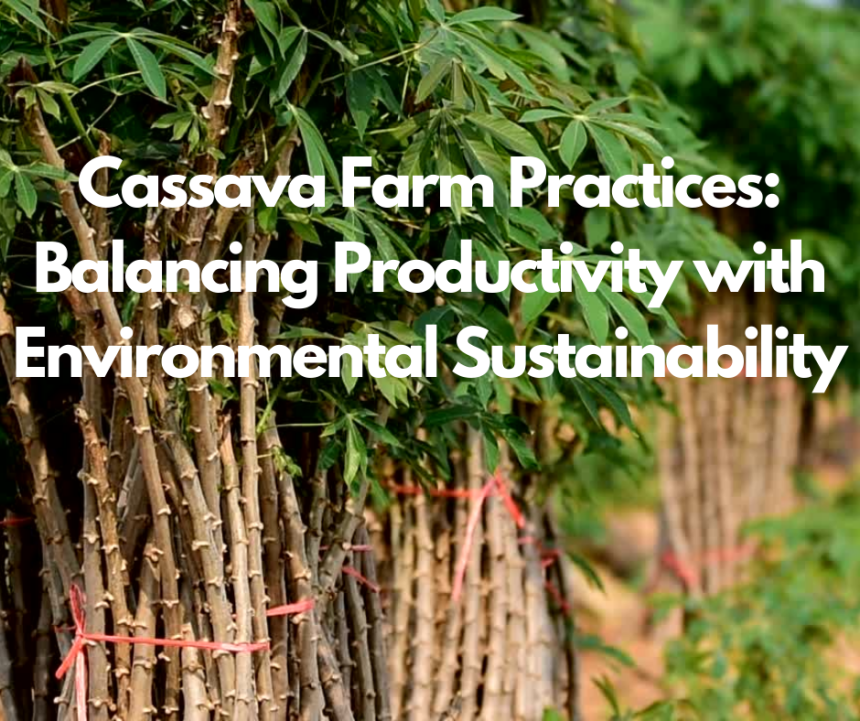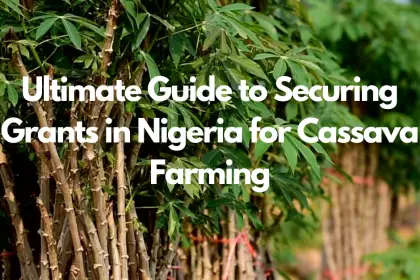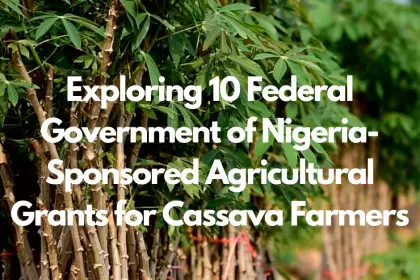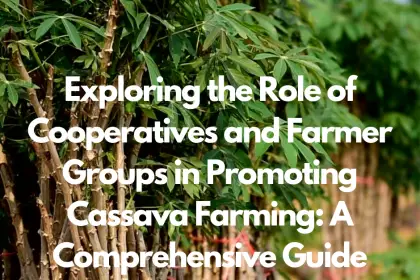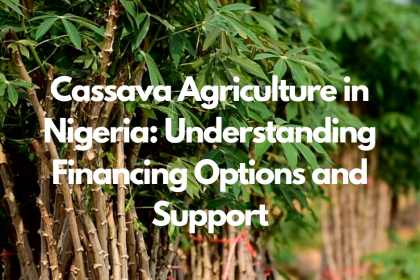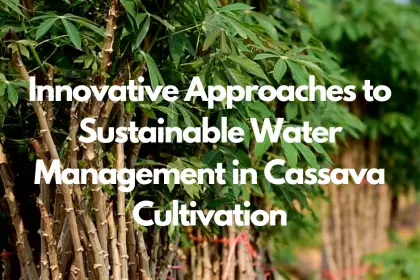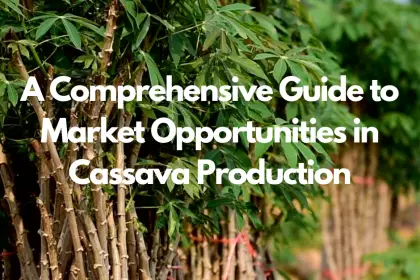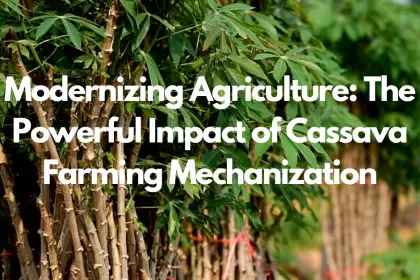Cassava farming practices are crucial for enhancing both agricultural productivity and environmental sustainability. As a staple crop in the tropics and subtropics, cassava plays a pivotal role in food security and the agricultural economy. Yet, the methods of planting cassava, alongside the broader cassava farming business plan, need to account for their impacts on soil, water, and biodiversity to ensure a balance between yield and environmental preservation. This awareness prompts a demand for practices that support sustainable development in the cassava market while prioritizing the multifunctionality of cassava farms.
Considering the significance of cassava as a reliable source of dietary energy and its increasing role in market trends, innovative and sustainable practices in cassava farming are indispensable. This article delves into eco-friendly cassava farm methods, examines how they influence agricultural outcomes and environmental health, and explores global and local initiatives aiming to promote sustainable cassava farming. Through a structured analysis of practices and their impacts, readers will gain insight into balancing productivity with environmental stewardship in the cassava farming sector.
The Importance of Cassava as a Staple Crop
Cassava, introduced to Africa by Portuguese explorers and traders from Brazil in the 16th and 17th centuries, has become a cornerstone of food security and agricultural economy across the continent. Its introduction marked a significant shift in agricultural practices and food consumption patterns, replacing traditional staples such as millet and yam in many parts of sub-Saharan Africa. This section explores the importance of cassava as a staple crop, highlighting its role in sustenance, economic stability, and adaptability to challenging environments.
- Historical Introduction and Global Significance
-
- Origin: Native to South America, cassava was introduced to Africa in the 16th and 17th centuries by Portuguese traders.
- Dominance in Africa: By 2020, over 60% of global cassava production was expected to be in sub-Saharan Africa, with Nigeria, the Democratic Republic of Congo, Ghana, Tanzania, and Mozambique leading the output.
- Nutritional Value: Cassava is a primary source of carbohydrates and dietary fiber, containing a moderate amount of protein, vitamins, and minerals. It provides about 150 calories per 100 grams, making it a vital energy source.
- Cassava’s Role in Food Security and Agricultural Economy
-
- Staple Food: In Africa, cassava is consumed by over half a billion people in various forms such as boiled, fried, or baked. It can also be processed into flour for bread, pasta, and other products.
- Economic Stability: Cassava is the most produced and the second most consumed crop in Nigeria, the world’s leading cassava producer. Africa produces over 54% of the world’s cassava, highlighting the continent’s significant contribution to the global cassava market.
- Resilience: The crop’s ability to flourish in low-rainfall areas with poor soil and withstand harsh climatic conditions makes it a reliable food source in regions prone to drought and famine.
- Industrial and Commercial Uses
-
- Diverse Applications: Beyond its role as a staple food, cassava is used to produce chips, flour, fufu, beer, and food additives. Its starch, whether modified or native, is crucial in the food and pharmaceutical industries.
- Challenges and Opportunities: Despite being the largest producer, Nigeria’s average yield is lower compared to other countries, indicating room for improvement in farming techniques. This presents an opportunity for innovations in sustainable cassava farming practices to enhance yield and quality.
Cassava’s introduction and its evolution into a staple crop in Africa underscore its significance in addressing food security, economic stability, and adaptation to challenging environments. Its versatility, nutritional value, and resilience contribute to its pivotal role in the agricultural landscapes of Africa and beyond.
Environmental Concerns with Cassava Farming
Cassava farming, while vital for food security and economic stability, poses several environmental concerns that necessitate careful management to mitigate adverse effects. These concerns range from soil nutrient depletion to water resource depletion and biodiversity impacts. Understanding these challenges is the first step toward developing sustainable cassava farming practices.
- Soil Health and Erosion
-
- Nutrient Depletion: Cassava’s nutrient absorption varies with root yield. At high yields, it removes significant amounts of nutrients, particularly potassium (K), at rates similar to other crops. However, at lower yields, it removes fewer nutrients (nitrogen [N], phosphorus [P], and K) than many other crops.
- Soil Erosion: On slopes, cassava cultivation can lead to greater erosion compared to other crops under similar conditions. Implementing good agronomic practices, such as:
-
- Adequate fertilization
- Closer plant spacing
- Planting on contour ridges
These can reduce soil erosion by 50-90%.
- Water Resources and Biodiversity
-
- Water Pollution and Usage: Cassava processing generates substantial waste, risking water pollution and resource depletion. This is especially critical during the dry season when water levels are naturally lower.
- Biodiversity and Habitat: Although direct evidence linking cassava cultivation to significant biodiversity loss is limited, the crop has been associated with deforestation in some regions, leading to habitat destruction.
- Chemical Concerns and Soil Degradation
-
- Cyanide Release: Processing cassava releases cyanide, necessitating careful management of waste to prevent environmental contamination.
- Soil Degradation and Monoculture: Frequent cassava monoculture can degrade soil quality and diminish biodiversity. Moreover, the high demand for water, coupled with the use of chemical fertilizers and pesticides, can exacerbate greenhouse gas emissions and strain water resources in areas with limited availability.
Addressing these environmental concerns involves integrating sustainable practices into the cassava farming business plan, focusing on methods of planting cassava that are both productive and environmentally friendly. This ensures the long-term viability of cassava farms and their surrounding ecosystems, contributing positively to the cassava market’s sustainability.
Practices for Sustainable Cassava Farming
Incorporating sustainable practices into cassava farming is essential for balancing productivity with environmental sustainability. The “Save and Grow” guide promotes an ecosystem-based approach that is particularly beneficial in tropical developing countries. This involves a series of integrated practices designed to enhance cassava yield while preserving environmental integrity.
Key Sustainable Practices for Cassava Farming:
- High-Yield and Disease-Resistant Varieties:
-
- Promote the use of high-yield cassava stems and commercialization to improve productivity.
- Implement disease-resistant cassava varieties and proper crop rotation to manage pests and diseases effectively.
- Soil and Water Conservation:
-
- Practice conservation tillage methods such as strip, minimum, and zero tillage to protect soil structure and reduce erosion.
- Utilize mulching and cover crops to conserve soil water, reduce runoff, and suppress weeds.
- Encourage the proliferation of soil biota through the cultivation of a diverse range of plant species, including trees and shrubs.
- Climate-Smart and Efficient Practices:
-
- Adopt climate-smart agricultural practices like rainwater harvesting to mitigate the impacts of changing weather patterns.
- Promote the adoption of agricultural machinery for increased efficiency and reduced labor.
- Community and Gender-Inclusive Strategies:
-
- Strengthen community-based seed systems for access to quality planting material.
- Implement gender-inclusive programs addressing the specific needs of women in cassava farming.
Addressing Challenges through Integrated Approaches:
- Pest and Disease Management:
-
- Use integrated pest management (IPM) practices.
- Provide training on identifying and managing pest and disease issues.
- Access to Markets and Knowledge:
-
- Establish market linkages through cooperatives or farmer groups.
- Strengthen extension services for ongoing training in modern farming practices.
By embracing these sustainable cassava farming practices, farmers can achieve higher productivity and income while ensuring the long-term viability of their land and resources. These practices not only contribute to the cassava market’s sustainability but also support the broader goal of environmental preservation.
Case Studies on Sustainable Cassava Farming Practices
In the quest for sustainable cassava farming practices, several case studies across different regions have illuminated innovative approaches and the challenges faced in realizing these initiatives. These case studies offer a glimpse into the practical application of sustainable practices and their impact on the cassava market and farming communities.
- IDH and The Rockefeller Foundation in Nigeria:
-
- Approach: Implementing a block farming model and deploying a $2,000,000 grant to foster sustainable ecosystems and reduce food losses.
- Outcome: Aimed at improving livelihoods and reducing yield loss, showcasing the potential of Nigeria’s cassava industry for sustainable development.
- CASTRAP Project in Liberia and Alliance Cassava Program in Laos:
-
- Approach: Supporting smallholder farmers through good agronomic practices and adopting climate-smart approaches (CASTRAP); developing innovative solutions for cassava farming systems to boost productivity and sustainability (Alliance Cassava Program).
- Outcome: Both initiatives underscore the importance of integrating sustainable practices to ensure the viability of cassava farming in the face of climatic challenges and the need for innovation in farming systems.
- Policy and Commercialization Efforts in Nigeria and South Africa:
-
- Nigeria: Studies in Ikorodu, Lagos, highlight the critical need for policy stability, government support, and the promotion of high-yield cassava stems for sustainable development.
-
- Challenges: Farmers face unpredictable market conditions, insufficient governmental assistance, and policy instability.
- Solutions: Policy reforms and the reformation of cassava policy to ensure sustainability in the cassava industry.
- South Africa: Efforts to scale up cassava for industrial starch production face barriers such as the lack of a well-established cassava research program and an existing value chain.
-
- Opportunities: Importing 33% of its cassava starch, South Africa has a significant opportunity to develop its cassava industry by overcoming these barriers.
- Profitability and Technology in Nigeria, Tanzania, and Cameroon:
-
- Nigeria and Tanzania: Establishing commercially sustainable cassava seed systems has proven profitable, with critical demand drivers being the provision of new varieties and the need for healthy, certified seed.
- Cameroon: CassVita Inc. is developing technology to significantly increase cassava’s shelf life and improve farmers’ livelihoods through financial inclusion.
-
- Technology Impact: Aiming to reduce cassava spoilage and increase per capita income for farmers, showcasing the role of innovation in enhancing sustainability in the cassava farming sector.
These case studies demonstrate the multifaceted approach required to implement sustainable cassava farming practices effectively. From policy reforms and technological innovations to community-based initiatives and climate-smart agriculture, each case study provides valuable insights into the steps necessary to balance productivity with environmental sustainability in the cassava farming industry.
Impact of Sustainable Practices on Yield and Quality
The integration of sustainable practices in cassava farming has shown significant impacts on yield and quality, underlining the critical balance between agricultural productivity and environmental stewardship. A review of various studies and data reveals the multifaceted outcomes of these practices:
- Yield and Quality Improvements:
-
- A systematic map protocol by Shackelford et al. (2018) highlights that the adoption of improved cassava farming practices, including the use of high-yielding varieties and advanced processing technologies, has a positive impact on both yield and quality. This is particularly evident in Nigeria, where such practices have led to increased cassava production despite challenges such as the scarcity and high cost of inorganic fertilizers.
- The use of LINTUL5 to estimate potential, water- and nutrient-limited cassava yield gaps in Nigeria shows that nutrient limitation is a significant factor, accounting for 55.3% of the total yield gap. This underscores the importance of nutrient management in achieving higher yields.
- Efficiency Metrics:
-
- Sustainable technical efficiency averages at 81.60%, influenced positively by factors such as farming experience, social organization membership, education level, farm capital, and farm size. This indicates that experienced and well-connected farmers with access to capital and larger farms tend to achieve higher technical efficiency in cassava farming.
- Profit efficiency, on the other hand, averages at 30.40%, with determinants including farming experience, education, farm size, gender, and the use of tillage technology. This suggests that efficient resource allocation and the adoption of modern farming technologies can significantly impact the profitability of cassava farming.
- Allocative efficiency averages at 38.40%, with farm size, age, educational level, farming experience, gender, and tillage technology use being positive determinants. This points to the effective distribution of resources among cassava farmers who adopt sustainable practices and technologies.
- Adaptation to Climate Change:
-
- The impact of climate change on cassava production is significant, prompting farmers to adopt strategies for adaptation. These include planting improved cassava varieties, insuring farms against climate-related risks, and employing soil and water conservation techniques. Such measures not only contribute to mitigating the effects of climate change but also enhance the resilience of cassava farming systems.
The evidence suggests that sustainable cassava farming practices contribute to improved yield and quality, higher efficiency in production, and better adaptation to environmental challenges. These outcomes are crucial for ensuring the long-term viability of cassava as a staple crop, particularly in regions where it plays a vital role in food security and economic stability.
Technological Advances in Cassava Farming
In the realm of cassava farming, technological advances are paving the way for more efficient, sustainable practices. The integration of digital technology, genomic resources, and precision phenotyping tools are at the forefront of these innovations, offering promising avenues for enhancing cassava production.
- Digital Technology Integration:
-
- The Alliance’s initiative in Laos, involving the co-creation of agrometeorological services with over 110,000 farmers, exemplifies the power of digital technology in agriculture. This ICT-based information service provides farmers with vital weather and climate information, enabling them to make informed decisions regarding planting and harvesting times, thus optimizing yield and minimizing risks.
- The International Institute of Tropical Agriculture (IITA) has developed several digital tools for cassava farmers, including:
-
- Akilimo: Offers tailored recommendations for cassava farming.
- IITA Herbicide Calculator: Assists in determining the correct herbicide doses.
- Cassava Seed Tracker and GoSeed Tracker: Facilitate tracking and sourcing quality seeds.
- Cassava Matters and Cassava e-Market: Provide platforms for education and market access.
- Farming on Radio and Cassava Matters on YouTube: Extend outreach and educational content to farmers.
- Genomic Resources and Phenotyping:
-
- Genomic Resources:
-
- Thousands of simple sequence repeats (SSR) markers and a cassava haplotype map featuring millions of SNPs and indels have been developed. These resources are crucial for exploring genetic diversity, which is a key component in breeding programs aimed at crop improvement.
- High-throughput genotyping platforms, such as the GoldenGate assay and genotyping technologies based on multiplex sequencing platforms, allow for rapid and accurate high-density fingerprinting using SNP markers. This enables the identification of genetic variations linked to desirable traits, facilitating the selection of superior varieties.
- Phenotyping Tools:
-
- Instruments designed to quantify CIELAB color parameters are used to evaluate carotenoids content in cassava root samples, with near-infrared spectroscopy (NIRS) explored for carotenoids quantification with high prediction accuracy. These tools support the selection of nutrient-rich cassava varieties.
- Classical QTL analysis and genome-wide association studies (GWAS) mapping are utilized for genetic analysis of traits, identifying genes and quantitative trait loci (QTLs) associated with traits of interest. This precision in phenotyping aids in the development of cassava varieties with enhanced yield and quality.
These technological advances in cassava farming underscore the significant potential of digital technology, genomic resources, and phenotyping tools in revolutionizing cassava production. By harnessing these innovations, farmers can achieve higher yields, improved crop quality, and greater resilience to environmental challenges, contributing to the sustainability and profitability of the cassava farming business.
Challenges in Implementing Sustainable Practices
Implementing sustainable practices in cassava farming faces numerous challenges, each interlinked with the complex dynamics of agricultural ecosystems, socio-economic factors, and climate variability. Understanding these obstacles is crucial for devising effective strategies to overcome them.
- Seed System and Plant Health:
-
- Critical Seed System: The authors of the chapter “Developing Sustainable Seed Systems for Higher Productivity” emphasize the importance of a reliable seed system for the adoption of improved varieties. A well-functioning seed system is foundational for increased agricultural productivity.
- Pest and Disease Control: Cassava is vulnerable to several diseases and pests, including mosaic disease, cassava bacterial blight, anthracnose disease, bud necrosis, mealybugs, and green mites. These challenges necessitate robust pest and disease management strategies.
- Access to Quality Planting Materials: Farmers often encounter difficulties in accessing consistent and sufficient supplies of high-quality cassava cuttings and planting materials. This inconsistency can adversely affect crop performance and elevate the risk of disease and pest introduction.
- Environmental and Market Factors:
-
- Weather Variability: Climate change introduces unpredictable weather patterns, complicating cassava cultivation with droughts during rainy seasons and excessive rainfall during dry periods.
- Market Access and Price Fluctuations: Smallholders frequently lack information on market demands, prices, and consumer preferences, leading to reliance on middlemen and potentially unfair pricing.
- Infrastructure and Policy Limitations:
-
- Storage and Transportation: Challenges such as inadequate warehousing, unstable electricity, and poor road networks impede farmers from securing fair prices for their products, affecting both the quality and quantity of the harvest.
- Lack of Access to Credit: Many cassava farmers, particularly smallholders, struggle to access credit for purchasing inputs and investing in their farms.
- Inadequate Infrastructure: Poor transportation and storage facilities contribute significantly to post-harvest losses and limit market access.
- Policy Constraints: Inadequate or poorly implemented policies can hinder the development of cassava farming. There is a need for policies that support cassava farming, including research and development, market access, and infrastructure development.
Addressing these challenges requires a multifaceted approach that encompasses improvements in seed systems, pest and disease control measures, access to quality planting materials, and strategies to cope with weather variability. Additionally, enhancing market access, improving storage and transportation infrastructure, facilitating access to credit, and advocating for supportive policies are essential steps toward implementing sustainable cassava farming practices effectively.
Global and Local Initiatives for Sustainability
In the effort to enhance cassava farming sustainability, several global and local initiatives have been established, pooling knowledge, expertise, and resources to address both environmental and production challenges. These initiatives focus on developing sustainable management practices, conserving biodiversity, and improving production practices for cassava and other high-value commodities.
- Initiatives and Contributions:
-
- The Alliance in Laos is making strides in developing sustainable management and production practices specifically for cassava and banana. This initiative is pivotal for ensuring that cassava farming contributes positively to both the economy and the environment.
- The ASEAN-CGIAR Innovate for Food and Nutrition Security Regional Program is focused on an integrated approach to the conservation and utilization of nutrient-rich agrobiodiversity in Laos. This program aims to bolster food security while maintaining ecological balance.
- In the Greater Mekong Region, the Alliance collaborates with a regional network of experts and organizations. This collaboration is dedicated to improving conservation and restoration efforts for many threatened tree species, showcasing a broader commitment to environmental sustainability beyond cassava farming.
- Stakeholders and Their Roles:
-
- The Leventis Foundation, the African Cassava Agronomy Initiative (ACAI), and the Conservation Evidence group at the University of Cambridge are key stakeholders in mapping out sustainable cassava farming practices. Their involvement underscores the importance of collaborative efforts in bridging knowledge gaps and enhancing cassava farming sustainability.
- Utilization of the map developed by these stakeholders can lead to prioritizing primary research on knowledge gaps or secondary research on knowledge clusters. This strategic approach facilitates targeted advancements in cassava farming practices, ensuring that efforts are directed where they are most needed.
These initiatives and the involvement of key stakeholders represent a concerted effort to address the sustainability challenges faced by cassava farming. By focusing on sustainable management practices, conservation of biodiversity, and the development of integrated approaches to agricultural production, these efforts aim to ensure that cassava farming can be both environmentally sustainable and economically viable.
Conclusion
Throughout this exploration, we’ve delved into the intricate balance between increasing cassava production and conserving the environment, highlighting the crucial role of sustainable farming practices. From the adoption of eco-friendly methods and the implementation of advanced technological innovations to the challenges and initiatives aimed at fostering sustainability, it’s clear that collaborative, informed efforts are pivotal for the future of cassava farming. These practices not only promise to enhance yield and quality but also aim to secure the long-term viability of cassava as a staple crop, fundamental to food security and economic stability in many regions.
Moving forward, it is imperative that stakeholders across the board – from farmers to policymakers, and from local communities to international bodies – continue to join forces. The shared goal is to advance sustainable cassava farming techniques that are both productive and environmentally sound. By harnessing technological innovations, addressing challenges head-on, and leveraging global and local initiatives, there lies a path toward a sustainable future for cassava farming, one that harmonizes agricultural productivity with environmental stewardship. This commitment to sustainability is not just about securing the present but also about paving the way for future generations to thrive.
FAQs
What should be considered environmentally when growing cassava?
Cassava cultivation can have significant environmental impacts, particularly when grown in delicate ecosystems. This crop is known to exhaust the nutrients in the soil and can lead to severe erosion, especially when planted on sloped terrain or at the edges of forests.
What are the recommended agricultural practices for cassava?
Optimal cassava farming requires regions with an annual rainfall of at least 1000 mm and a rainy season that spans a minimum of six months, with each month receiving no less than 50 mm of rain. The soil should be deep (at least 30 cm), well-drained, and free from excessive sand, clay, stones, or salt. In areas prone to waterlogging, cassava should be planted on raised mounds or ridges to prevent root rot.
How does cassava cultivation benefit the environment?
Cassava can play a role in environmental restoration by rejuvenating soil quality. This improvement makes it possible for farmers to grow other profitable crops such as soybeans, corn, or legumes. By restoring degraded lands, cassava cultivation can potentially reduce greenhouse gas emissions, combat hunger, and help alleviate poverty, according to expert Villarino.
What methods can be employed to boost cassava yields?
To enhance cassava production, especially in arid regions, horizontal planting is recommended. The rapid multiplication technique is another method that can be utilized to generate a large supply of cassava stems, which serve as planting material for future planting seasons. It is also crucial to select and plant stems that are healthy, robust, and free from pests and diseases.

